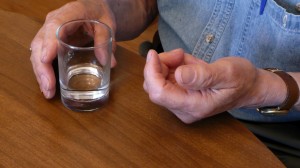Emergency Preparedness for People with Disabilities or Special Health Needs
Overlooked or Abandoned?
Every week I get one or another Google Alert about some group that is either not taking care of itself in an emergency or that has been overlooked by “the authorities.”
In our community CERT group, we do not have the where-with-all to take care of neighbors with disabilities. We don’t have specialized medical knowledge, or (expensive) specialized equipment or even the physical stamina to lift or move some of them. But . . .
We are aware of our neighbors and do our best to keep their needs in mind . . .
as we work on building our – and their — readiness to respond in the face of a disaster. As you build your own neighborhood group, here are
Some questions to ask:

from Lee Wilson, founder at The Egress Group. More at http://accessibleexitsigns.com/
Shelter-in-Place. When a heavy storm hits, the best course for most people is to shelter in place, assuming they have stored food, clothing, etc. The questions to ask your disabled neighbors:
- Do you have food supplies that you are able to prepare for yourself (canned food, water) or do you depend on regular food deliveries from Meals on Wheels or other food service?
- Do you use any electric or electronic devices to treat a chronic condition, such as breathing treatments or sleeping machines? What plans do you have for back-up power? (Oxygen tanks, battery back-up)
Needed travel. Do any of your neighbors need regular trips away from their home to get medical treatments like as kidney dialysis? In a severe weather situation, can your neighbor answer these questions:
- Do you know what to do if you are unable to reach your doctor for several days? (diet, hydration)
- Do you know where to go for treatment if your local clinic is closed? (addresses of alternate locations)
- Who would come to get you for dialysis if your regular caregiver isn’t available?
- What if the elevator isn’t working?
Evacuation. In the case of an evacuation, many people who may not appear disabled may need assistance. For example, people who are hard of hearing might not recognize the signal to evacuate. People with difficulty walking might not be able to negotiate stairs. People who can walk may not be able to handle door handles or locks. Questions to ask:
- Does our building/community have evacuation signage that incorporates signage for disabled people? (visual? touchable?)
- Is there a plan to find people ready and able to assist disabled people to evacuate?
- Is specialized evacuation equipment necessary, and available?
Practice and planning do make a difference.
The National Fire Protection Association’s 2007 Emergency Evacuation Planning Guide for People with Disabilities tells the following story.
During the 1993 bombing of the World Trade Center, a man with a mobility impairment was working on the 69th floor. With no plan or devices in place, it took over six hours to evacuate him. In the 2001 attack on the World Trade Center, the same man had prepared himself to leave the building using assistance from others and an evacuation chair he had acquired and had under his desk. It only took 1 hour and 30 minutes to get him out of the building this second time.
Perhaps you can share this story with friends and with your CERT team to stimulate some creative thinking.
Virginia
Your Emergency Plan Guide Team
Forward this email to someone you know who could use the information. One out of five Americans has some sort of disability.

